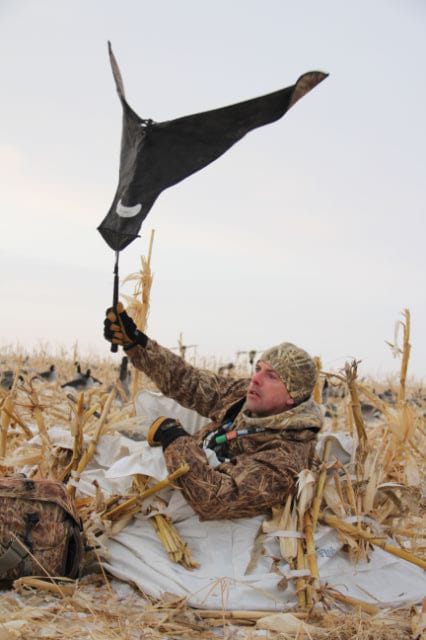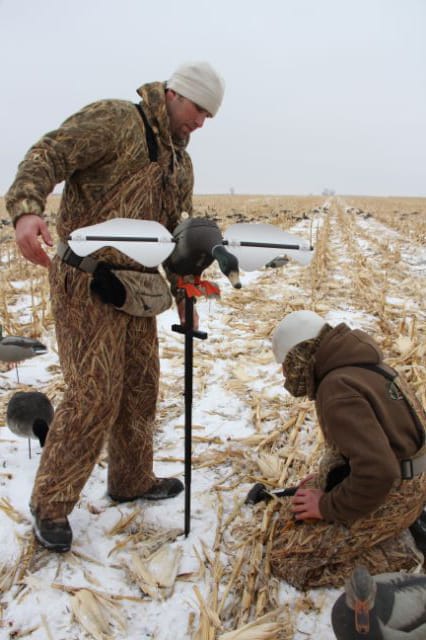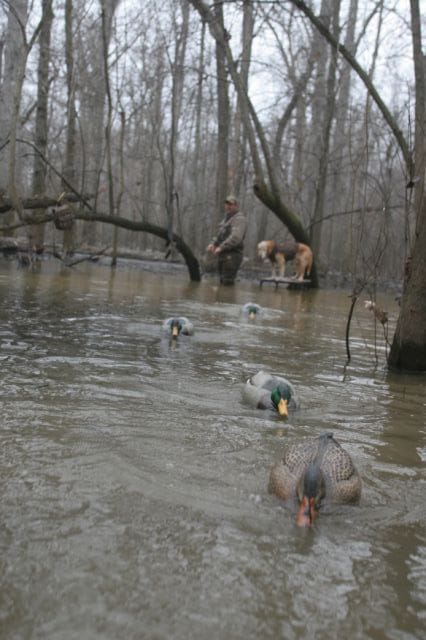by David Hart
Watch a flock of ducks on a city park pond or a group of geese on a golf course, and one thing will stand out: Motion. They swim, splash, walk and flap their wings. Aside from the occasional sleeping bird, the entire flock is in a perpetual state of motion.

A flag can get the attention of distant geese, but don’t use it when the birds are committed or already working your spread.
When viewing flooded fields and timber from the sky, wakes and movement in the water can be seen long before actually ducks on the water are visible.
Skilled waterfowlers understand that in order to fool ducks and geese, it’s vital to imitate, to some extent, the natural motion that occurs from a flock that has lit on the ground or water. Whether it’s a handful of mallard decoys on a marsh or 10 dozen full-body goose decoys in a corn field, adding some sort of motion to the spread can tip the balance in your favor and help in decoying them in for a shot.
Flag Them In
One of the best ways to pull in a flock of geese passing in the distance is with a flag. Little more than a piece of goose-colored cloth cut into the profile of a flying bird and attached to a handle, a flapping goose flag can draw the attention of distant geese and alert them to your presence. That’s about all they are meant to do, though.
“One of the biggest mistakes I see with flags is that guys will use them when the geese are coming right to their spreads or when the birds are directly overhead,” says Mark Brendemuehl, an Avery Outdoors territory manager and expert waterfowl hunter. “Flags are really just meant to let passing geese know you are there, so once they turn and come toward me, I’ll quit flagging and start calling.”
Spin Cycle
Spinning-wing decoys don’t just draw the attention of passing ducks, they can pull birds out of the sky and into your decoys. Although he’s not a big fan of them, Mark admits spinners can be deadly at decoying ducks under the right conditions.

Spinning-wing decoys can be highly effective in certain situations. Use three or four in dry fields for extra pulling power.
The rapid flash of battery-powered wings excels in dry fields, particularly in the early season. They can work well over water, too. However, experience has taught Mark that there are times when they not only don’t work, they actually spook ducks.
“Ducks can be come conditioned to avoid them later in the season, and they don’t seem to work as well on cloudy days,” he says. “If you are using one, and it’s not working, pull it.”
Pay attention. If ducks are flaring, it may well be that noisy flapping contraption in the middle of your decoy spread.
Mark has also learned that geese tend to avoid spinning-wing decoys. That presents a dilemma for hunters who have an opportunity for ducks and geese on the same hunt. Do you jump up and turn off the spinners when you see geese? Or do you turn it on when ducks are in the sky?
Jerk It
Spinners are illegal in a handful of states, and some hunters reject the notion of using any device powered by battery. They understand the importance of motion, though, which is why many veteran hunters use a jerk cord, one of the oldest tricks in the book. There’s no easier and inexpensive way to bring a water spread to life. Jerk cords are little more than a string tied to a line of decoys. They are easy to make, but some companies like Avery Outdoors sell jerk-cord kits that include a length of string, a bungee cord, a weight and clips to quickly attach several decoys to the cord.
Jerk cords excel on calm days and on small waters. Jerk cords are also deadly in standing timber. Passing mallards can’t resist the combination of urgent calling and splashing or swimming decoys.

A jerk cord can add life to a lifeless decoy spread. They excel in flooded timber and on small, calm bodies of water, but they work anywhere your decoys need a little motion.
While many waterfowlers assume there’s no need for added motion on a breezy morning, Mark will use still use a jerk cord even when a slight wind bounces and shifts his decoys.
“I just pull a little harder to get them to make a lot of commotion. That can look like ducks feeding or splashing, which can give you the upper hand if you are competing against other hunters,” he says.
Batteries Required
A host of products designed to add life to a duck or goose spread require batteries. Some splash water, a few wobble, others actually fly in circles over the water or ground. They all draw the attention of passing birds and can pull them into shooting range when a lifeless spread can’t.
The problem, says Mark, is that battery-powered decoys are prone to repair issues, and the batteries seem to go dead when you least expect it. Smart hunters check the batteries before they hunt, of course, or they simply carry spares. However, they can add another layer of complication to the hunt.
“I try to avoid complications,” Mark adds. “I hunt a lot of places that require a pretty long walk, so I try not to carry extra weight or something that may or may not work when I get there. I know a jerk cord and a flag will work every time.”
What you use is somewhat less important than the mere fact that you add some motion to your decoy spread. It doesn’t matter if it’s powered by your hands or a 12-volt battery. A lively decoy spread will outdraw a lifeless spread every time.
The Union Sportsmen’s Alliance website is designed to provide valuable articles about hunting, fishing and conservation for members of AFL-CIO affiliated labor unions and all sportsmen and sportswomen who appreciate hunting and fishing and want to preserve our outdoor heritage for future generations. If you would like your own story and experience from the outdoors to be considered for our website, please email us at USAmembers@unionsportsmen.org.




